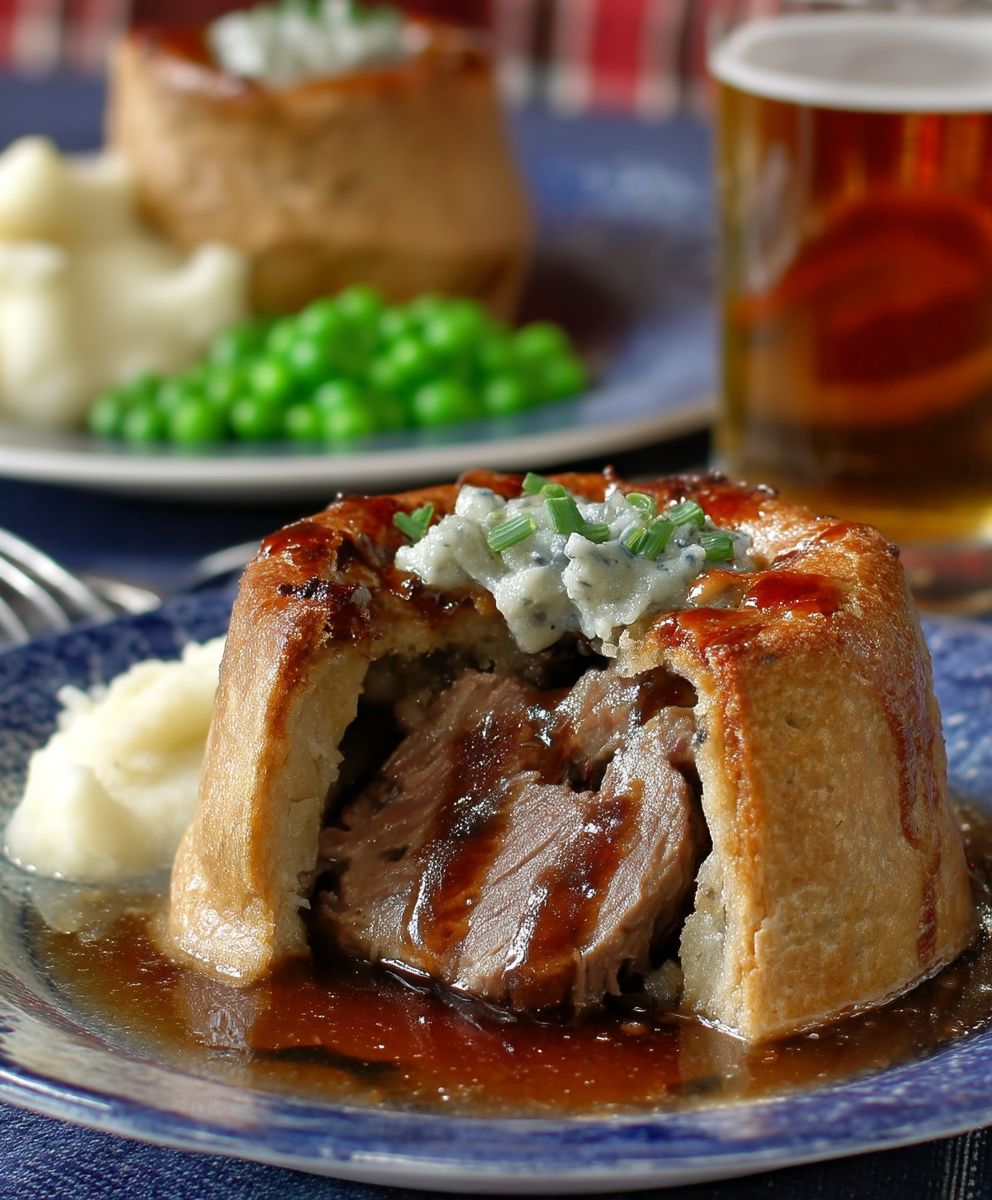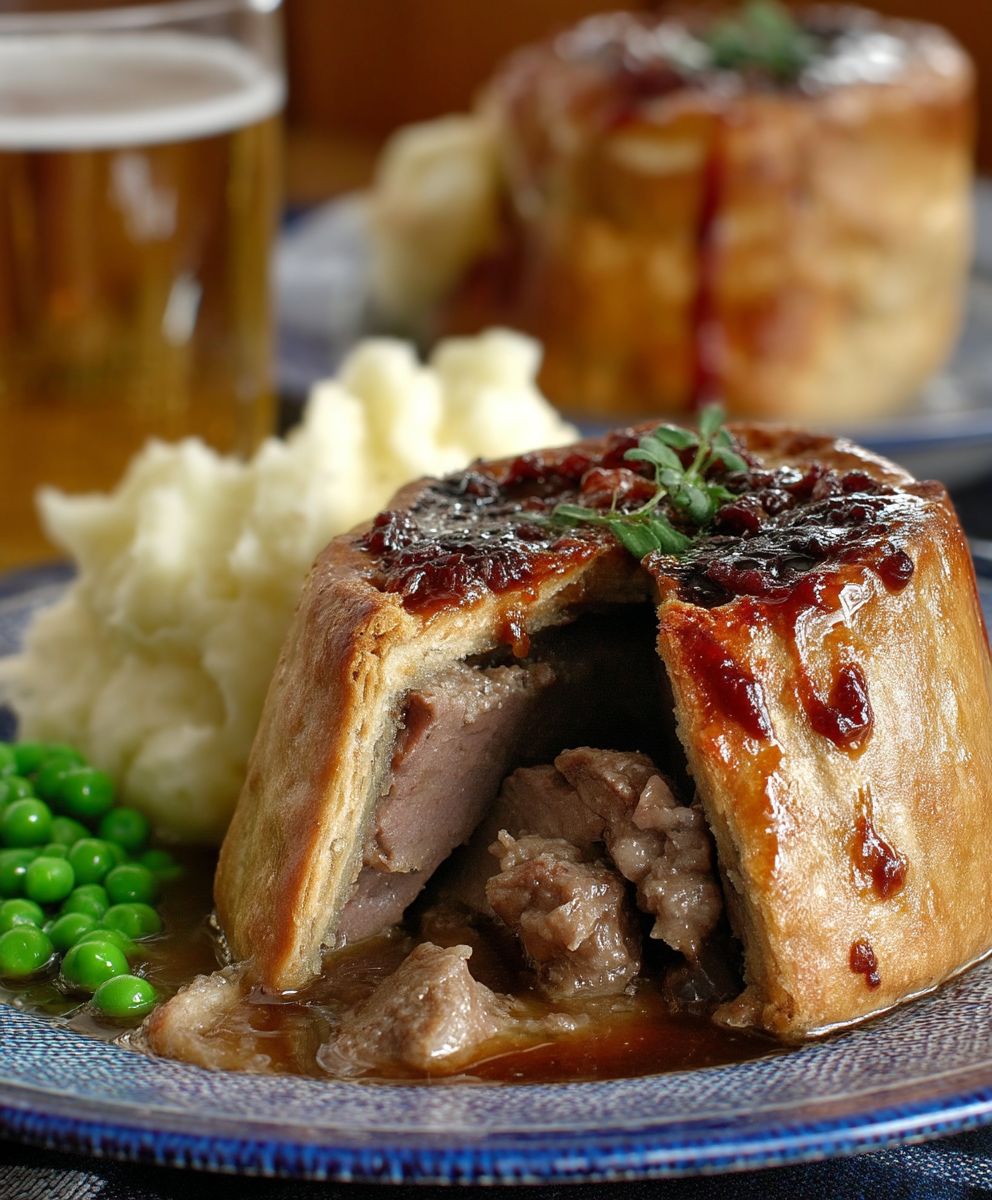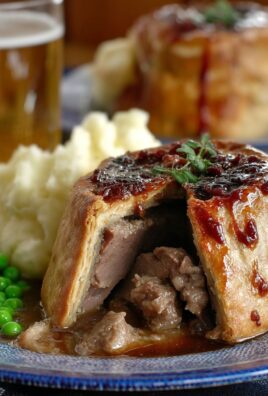Steak Pudding: Prepare to indulge in a culinary masterpiece that’s far more exciting than its humble name suggests! Forget everything you think you know about pudding; this isn’t a sweet, creamy dessert. We’re diving headfirst into a rich, savory delight, a hearty and comforting dish that’s been warming hearts and bellies for generations.
Steak pudding, a traditional British dish, boasts a history as deep and flavorful as the pudding itself. Originating in the northern regions of England, it was a staple for working-class families, offering a filling and affordable meal using readily available ingredients. Think of it as the ultimate comfort food, a warm hug on a cold day. Its a testament to resourcefulness and the ability to create something truly special from simple beginnings.
What makes steak pudding so irresistible? It’s the perfect marriage of tender, slow-cooked steak, enveloped in a suet pastry that’s both light and incredibly satisfying. The savory gravy, infused with the rich flavors of the beef, onions, and often a touch of ale, seeps into the pastry, creating a symphony of textures and tastes. People adore it for its deeply comforting nature, its ability to satisfy even the heartiest of appetites, and the sheer joy of experiencing a truly authentic and time-honored dish. It’s a dish that speaks of tradition, family, and the simple pleasures of life. So, let’s get started and create your own unforgettable steak pudding!
Ingredients:
- For the Filling:
- 1.5 lbs Beef Chuck Steak, cut into 1-inch cubes
- 2 tbsp Olive Oil
- 1 large Onion, chopped
- 2 Carrots, peeled and chopped
- 2 Celery Stalks, chopped
- 2 cloves Garlic, minced
- 1 tbsp Tomato Paste
- 1 tbsp All-Purpose Flour
- 1 cup Beef Broth
- 1/2 cup Dark Beer (such as stout or porter)
- 1 tbsp Worcestershire Sauce
- 1 tsp Dried Thyme
- 1/2 tsp Dried Rosemary
- 1 Bay Leaf
- Salt and Black Pepper to taste
- For the Suet Pastry:
- 8 oz Shredded Beef Suet (chilled)
- 16 oz All-Purpose Flour
- 1 tsp Baking Powder
- 1/2 tsp Salt
- Approximately 1/2 cup Cold Water
- Equipment:
- 2-quart Pudding Basin
- Parchment Paper
- Aluminum Foil
- String or Kitchen Twine
Preparing the Filling:
- Sear the Beef: Season the beef cubes generously with salt and pepper. Heat the olive oil in a large, heavy-bottomed pot or Dutch oven over medium-high heat. Working in batches, sear the beef on all sides until nicely browned. This step is crucial for developing rich flavor. Don’t overcrowd the pot, or the beef will steam instead of sear. Remove the seared beef from the pot and set aside.
- Sauté the Vegetables: Add the chopped onion, carrots, and celery to the pot and cook over medium heat until softened, about 8-10 minutes. Stir occasionally to prevent burning. The vegetables should be tender and slightly caramelized.
- Add Garlic and Tomato Paste: Stir in the minced garlic and tomato paste and cook for another minute until fragrant. The tomato paste will add depth and richness to the sauce.
- Dust with Flour: Sprinkle the flour over the vegetables and cook for 1-2 minutes, stirring constantly. This will help thicken the sauce. Make sure the flour is evenly distributed and cooked through.
- Deglaze the Pot: Gradually pour in the beef broth and dark beer, scraping up any browned bits from the bottom of the pot. These browned bits are packed with flavor and will enhance the overall taste of the pudding.
- Add Seasonings and Beef: Return the seared beef to the pot. Add the Worcestershire sauce, dried thyme, dried rosemary, and bay leaf. Stir to combine.
- Simmer: Bring the mixture to a simmer, then reduce the heat to low, cover the pot, and cook for at least 2-3 hours, or until the beef is very tender and easily falls apart. Stir occasionally to prevent sticking. The longer it simmers, the more flavorful it will become. You can also cook this in a slow cooker on low for 6-8 hours.
- Adjust Seasoning: Once the beef is tender, remove the bay leaf and taste the filling. Adjust the seasoning with salt and pepper as needed. The filling should be rich, savory, and well-seasoned.
- Cool Slightly: Let the filling cool slightly before assembling the pudding. This will prevent the pastry from becoming soggy.
Making the Suet Pastry:
- Combine Dry Ingredients: In a large bowl, combine the flour, baking powder, and salt. Whisk together to ensure the baking powder is evenly distributed.
- Add Suet: Add the shredded beef suet to the flour mixture. Using your fingertips, rub the suet into the flour until it resembles coarse breadcrumbs. The suet should be evenly distributed throughout the flour. Keep the suet as cold as possible during this process.
- Add Water: Gradually add the cold water, a tablespoon at a time, mixing until the dough just comes together. Be careful not to overmix, as this will develop the gluten and make the pastry tough. The dough should be slightly sticky but not overly wet.
- Form a Disc: Turn the dough out onto a lightly floured surface and gently form it into a disc. Wrap the disc in plastic wrap and refrigerate for at least 30 minutes. This will allow the gluten to relax and make the pastry easier to handle.
Assembling the Steak Pudding:
- Prepare the Pudding Basin: Grease the inside of the 2-quart pudding basin with butter or shortening. This will help the pudding release easily after cooking.
- Roll Out the Pastry: On a lightly floured surface, roll out two-thirds of the pastry to a circle large enough to line the pudding basin, with some overhang. The pastry should be about 1/4 inch thick.
- Line the Basin: Carefully lift the pastry and place it into the prepared pudding basin, pressing it gently against the sides and bottom. Make sure there are no air pockets. The pastry should extend slightly over the rim of the basin.
- Fill the Pudding: Pour the cooled beef filling into the pastry-lined basin, leaving about 1 inch of space at the top.
- Create the Lid: Roll out the remaining pastry to a circle large enough to cover the top of the pudding basin. The pastry should be about 1/4 inch thick.
- Cover the Filling: Place the pastry lid over the filling, pressing the edges firmly against the overhanging pastry to seal. Trim off any excess pastry and crimp the edges to create a decorative seal.
- Prepare the Cover: Cut a large circle of parchment paper and a slightly larger circle of aluminum foil. Place the parchment paper on top of the foil.
- Cover the Pudding: Place the parchment paper and foil over the top of the pudding basin, pleating them in the center to allow for expansion during cooking. Secure the cover tightly around the rim of the basin with string or kitchen twine. This will prevent water from entering the pudding during steaming.
Cooking the Steak Pudding:
- Steam the Pudding: Place a trivet or upturned saucer in the bottom of a large pot. Place the pudding basin on the trivet. Pour boiling water into the pot until it comes about halfway up the sides of the basin.
- Simmer: Cover the pot tightly and bring the water to a gentle simmer. Steam the pudding for 4-5 hours, or until the pastry is cooked through and the filling is heated through. Check the water level periodically and add more boiling water as needed to maintain the water level. It’s crucial to keep the water simmering gently throughout the cooking process.
- Check for Doneness: To check for doneness, insert a skewer into the center of the pudding. If it comes out clean, the pudding is ready. The pastry should be golden brown and firm to the touch.
- Remove and Rest: Carefully remove the pudding basin from the pot. Let the pudding rest for 10-15 minutes before unmolding. This will allow the filling to settle and make it easier to unmold.
Serving the Steak Pudding:
- Unmold: Remove the foil and parchment paper from the pudding basin. Run a thin knife around the edge of the pudding to loosen it from the basin. Place a serving plate over the top of the basin and invert it quickly. Gently tap the bottom of the basin to release the pudding.
- Serve: Serve the steak pudding hot, sliced into wedges. It’s delicious on its own or with a side of mashed potatoes, peas, or gravy. Enjoy!

Conclusion:
This isn’t your average weeknight dinner; it’s a culinary adventure waiting to happen! I know, I know, “Steak Pudding” might sound a little unconventional. But trust me, once you taste the rich, savory depths of this dish, you’ll understand why it’s an absolute must-try. The tender, slow-cooked steak, infused with the deep flavors of stout and herbs, nestled beneath a golden, perfectly steamed suet crust it’s a symphony of textures and tastes that will leave you utterly satisfied. Its comfort food elevated to an art form, a hearty and warming meal perfect for a chilly evening.
But why is this particular Steak Pudding so special? It’s all about the details. We’ve taken the time to perfect the balance of flavors, ensuring that each ingredient complements the others beautifully. The slow cooking process guarantees incredibly tender steak, while the suet crust provides a delightful contrast crisp on top and wonderfully soft underneath. It’s a dish that’s both comforting and exciting, familiar yet refreshingly different.
And the best part? It’s surprisingly versatile! While I personally love serving it with a generous dollop of creamy mashed potatoes and a side of buttered greens, the possibilities are endless. For a lighter meal, try pairing it with a fresh, vibrant salad. Or, if you’re feeling adventurous, why not add a layer of sliced mushrooms or some diced root vegetables to the filling? A sprinkle of grated cheese over the crust before steaming adds a lovely cheesy note.
Looking for variations? Consider using different cuts of steak. While chuck steak is my go-to for its rich flavor and affordability, you could also experiment with braising steak or even short ribs for an even more decadent experience. You can also play around with the herbs and spices. A pinch of smoked paprika or a dash of Worcestershire sauce can add a unique depth of flavor. And for a vegetarian twist, you could substitute the steak with hearty mushrooms and lentils for a equally satisfying pudding.
Don’t be intimidated by the slightly longer cooking time. The beauty of this recipe is that it’s mostly hands-off. Once you’ve assembled the pudding, it simply simmers away, filling your kitchen with the most incredible aromas. It’s the perfect dish to prepare on a weekend afternoon, allowing you to relax and enjoy the anticipation of a truly special meal.
I truly believe that this Steak Pudding recipe is a winner. It’s a dish that’s guaranteed to impress your family and friends, and it’s a fantastic way to showcase your culinary skills. So, what are you waiting for? Gather your ingredients, roll up your sleeves, and get ready to create something truly extraordinary.
I’m so excited for you to try this recipe, and I can’t wait to hear about your experience! Did you make any variations? What did you serve it with? What did your family think? Please, share your photos and stories in the comments below. I’m always eager to learn from your culinary adventures and see how you’ve made this recipe your own. Happy cooking!
Steak Pudding: A Delicious and Comforting Recipe
Hearty Steak Pudding with tender beef in rich gravy, encased in savory suet pastry. A classic, comforting British dish.
Ingredients
- 1.5 lbs Beef Chuck Steak, cut into 1-inch cubes
- 2 tbsp Olive Oil
- 1 large Onion, chopped
- 2 Carrots, peeled and chopped
- 2 Celery Stalks, chopped
- 2 cloves Garlic, minced
- 1 tbsp Tomato Paste
- 1 tbsp All-Purpose Flour
- 1 cup Beef Broth
- 1/2 cup Dark Beer (such as stout or porter)
- 1 tbsp Worcestershire Sauce
- 1 tsp Dried Thyme
- 1/2 tsp Dried Rosemary
- 1 Bay Leaf
- Salt and Black Pepper to taste
- 8 oz Shredded Beef Suet (chilled)
- 16 oz All-Purpose Flour
- 1 tsp Baking Powder
- 1/2 tsp Salt
- Approximately 1/2 cup Cold Water
Instructions
- Season the beef cubes generously with salt and pepper. Heat the olive oil in a large, heavy-bottomed pot or Dutch oven over medium-high heat. Working in batches, sear the beef on all sides until nicely browned. Remove the seared beef from the pot and set aside.
- Add the chopped onion, carrots, and celery to the pot and cook over medium heat until softened, about 8-10 minutes. Stir occasionally.
- Stir in the minced garlic and tomato paste and cook for another minute until fragrant.
- Sprinkle the flour over the vegetables and cook for 1-2 minutes, stirring constantly.
- Gradually pour in the beef broth and dark beer, scraping up any browned bits from the bottom of the pot.
- Return the seared beef to the pot. Add the Worcestershire sauce, dried thyme, dried rosemary, and bay leaf. Stir to combine.
- Bring the mixture to a simmer, then reduce the heat to low, cover the pot, and cook for at least 2-3 hours, or until the beef is very tender. Stir occasionally.
- Once the beef is tender, remove the bay leaf and taste the filling. Adjust the seasoning with salt and pepper as needed.
- Let the filling cool slightly before assembling the pudding.
- In a large bowl, combine the flour, baking powder, and salt. Whisk together.
- Add the shredded beef suet to the flour mixture. Using your fingertips, rub the suet into the flour until it resembles coarse breadcrumbs.
- Gradually add the cold water, a tablespoon at a time, mixing until the dough just comes together. Be careful not to overmix.
- Turn the dough out onto a lightly floured surface and gently form it into a disc. Wrap the disc in plastic wrap and refrigerate for at least 30 minutes.
- Grease the inside of the 2-quart pudding basin with butter or shortening.
- On a lightly floured surface, roll out two-thirds of the pastry to a circle large enough to line the pudding basin, with some overhang.
- Carefully lift the pastry and place it into the prepared pudding basin, pressing it gently against the sides and bottom.
- Pour the cooled beef filling into the pastry-lined basin, leaving about 1 inch of space at the top.
- Roll out the remaining pastry to a circle large enough to cover the top of the pudding basin.
- Place the pastry lid over the filling, pressing the edges firmly against the overhanging pastry to seal. Trim off any excess pastry and crimp the edges to create a decorative seal.
- Cut a large circle of parchment paper and a slightly larger circle of aluminum foil. Place the parchment paper on top of the foil.
- Place the parchment paper and foil over the top of the pudding basin, pleating them in the center to allow for expansion during cooking. Secure the cover tightly around the rim of the basin with string or kitchen twine.
- Place a trivet or upturned saucer in the bottom of a large pot. Place the pudding basin on the trivet. Pour boiling water into the pot until it comes about halfway up the sides of the basin.
- Cover the pot tightly and bring the water to a gentle simmer. Steam the pudding for 4-5 hours, or until the pastry is cooked through and the filling is heated through. Check the water level periodically and add more boiling water as needed to maintain the water level.
- To check for doneness, insert a skewer into the center of the pudding. If it comes out clean, the pudding is ready.
- Carefully remove the pudding basin from the pot. Let the pudding rest for 10-15 minutes before unmolding.
- Remove the foil and parchment paper from the pudding basin. Run a thin knife around the edge of the pudding to loosen it from the basin. Place a serving plate over the top of the basin and invert it quickly. Gently tap the bottom of the basin to release the pudding.
- Serve the steak pudding hot, sliced into wedges.
Notes
- Searing the beef in batches is crucial for developing a rich flavor. Don’t overcrowd the pot.
- Simmering the filling for a long time is key to tender beef and a flavorful gravy. You can also use a slow cooker.
- Keep the suet as cold as possible when making the pastry.
- Don’t overmix the pastry dough.
- Make sure the water level in the pot remains consistent during steaming.
- Serve with mashed potatoes, peas, or gravy for a complete meal.




